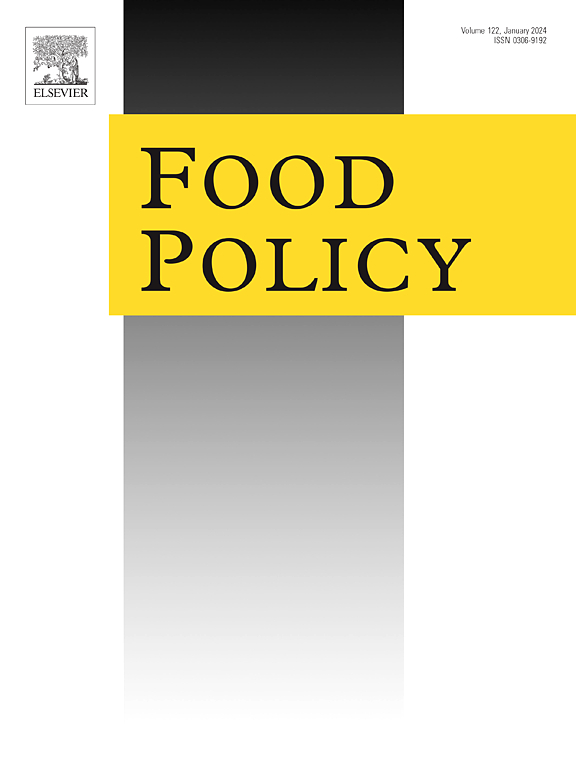我们是否可以通过nutrition - score和网站设计来提高在线食品购买的健康度?
IF 6
1区 经济学
Q1 AGRICULTURAL ECONOMICS & POLICY
引用次数: 0
摘要
为了鼓励人们选择更健康的食品,一些欧洲国家在包装正面采用了“营养评分”标签。这个自愿标签是为在超市里展示的产品设计的。尽管数字化转型,但nutrition - score在在线环境中的影响仍未得到充分研究。本研究评估了三种营养评分干预对网上食品购买的影响。比利时参与者(N = 1151)在一个专门建造的虚拟在线超市里用规定的购物清单购物。参与者被随机分配到七个条件之一,包括最多三种干预措施:营养评分存在(否/是),根据营养评分进行默认产品排序(是/否),以及根据营养评分进行过滤和排序的选项(否/是)。感兴趣的结果是英国食品标准局营养分析系统的平均饮食评分以及营养评分为A、B、C、D和e的食品的百分比和支出。与对照组相比,仅仅存在营养评分并不影响感兴趣的结果。将默认的按字母顺序排序改为按健康状况排序提高了平均饮食得分,增加了营养得分为A和B的产品的购买量,减少了营养得分为D和e的产品的购买量。相比之下,当存在时,用户驱动的按健康状况过滤和排序产品的选项几乎没有被使用(< 10%),而且这种干预没有改变购买量。总之,改变产品的默认分类,让更健康的产品先出现,可能会鼓励消费者购买更健康的产品。本文章由计算机程序翻译,如有差异,请以英文原文为准。
Can we improve the healthiness of online food purchases through the Nutri-Score and site design?
To encourage healthier food choices, several European countries have adopted the Nutri-Score front-of-pack label. This voluntary label was designed for products on display within supermarkets. Despite the digital transition, the impact of Nutri-Score in an online environment remains under-researched. This study assesses the impact of three Nutri-Score interventions on online food purchasing. Belgian participants (N = 1151) shopped for groceries in a purpose-built Virtual Online Supermarket with a prescribed shopping list. Participants were randomly assigned to one of seven conditions comprising up to three interventions: Nutri-Score presence (no/yes), default product sorting by Nutri-Score (yes/no), and the options to filter and sort by Nutri-Score (no/yes). The outcomes of interest were mean UK Food Standards Agency nutrient profiling system diet score and the percentage of and expenditure on food items with Nutri-Score A, B, C, D, and E. Compared to the control group, the mere presence of Nutri-Scores did not affect the outcomes of interest. Changing the default sorting from alphabetically to by healthiness improved the mean diet score, increased the purchase of items with Nutri-Scores A and B, and reduced the purchase of items with Nutri-Scores D and E. In contrast, when present, the user-driven options to filter and sort the products by healthiness were barely used (<10 %), and this intervention didn’t change purchases. In sum, changing the default sorting of products so that healthier products appear first may encourage consumers to buy healthier.
求助全文
通过发布文献求助,成功后即可免费获取论文全文。
去求助
来源期刊

Food Policy
管理科学-农业经济与政策
CiteScore
11.40
自引率
4.60%
发文量
128
审稿时长
62 days
期刊介绍:
Food Policy is a multidisciplinary journal publishing original research and novel evidence on issues in the formulation, implementation, and evaluation of policies for the food sector in developing, transition, and advanced economies.
Our main focus is on the economic and social aspect of food policy, and we prioritize empirical studies informing international food policy debates. Provided that articles make a clear and explicit contribution to food policy debates of international interest, we consider papers from any of the social sciences. Papers from other disciplines (e.g., law) will be considered only if they provide a key policy contribution, and are written in a style which is accessible to a social science readership.
 求助内容:
求助内容: 应助结果提醒方式:
应助结果提醒方式:


